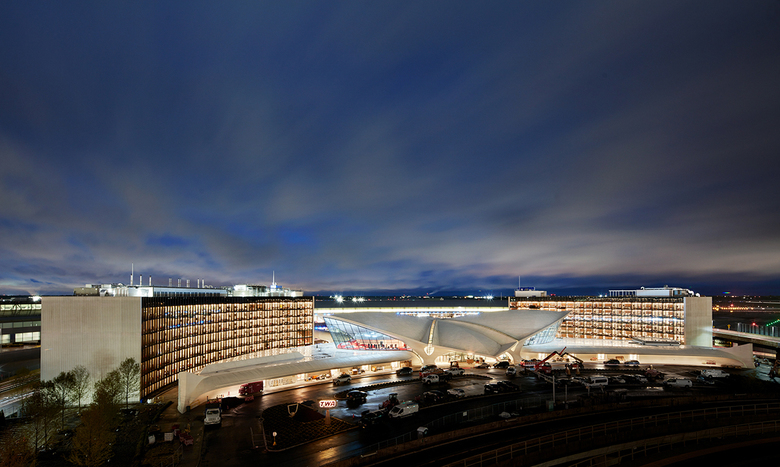The 512 Quietest Places at JFK
John Hill
1. julho 2019
Photo: David Mitchell, courtesy of TWA Hotel
While the new TWA Hotel at New York's JFK Airport is highlighted by the renovation of Eero Saarinen's TWA Flight Center from 1962, it's the two seven-story wings housing 512 hotel rooms that make the project financially feasible. Furthermore, it's the curtain walls made with seven layers of glass that make a hotel in the middle of an airport acoustically feasible.
Location: JFK International Airport, New York, NY
Client: MCR/Morse Development
Architect (Project): Beyer Blinder Belle
Architect (Hotel): Lubrano Ciavarra Architects
Facade Consultant: Front Inc.
Acoustics: Cerami & Associates
Structural Engineer: ARUP
Civil Engineer: Langan Engineering & Environmental Services
MEP/FP Engineer: Jaros, Baum & Bolles
Manufacturer: Fabbrica
Product: Triple-glazed unitized curtain wall
Glass: AGC Interpane
The gray glass reflects the Saarinen building. (Photo: John Hill/World-Architects)
Anne Marie Lubrano and Lea Ciavarra of Lubrano Ciavarra Architects know who the star of the TWA Hotel is. They designed the hotel's curving wings as a neutral backdrop for Saarinen's iconic, mid-century masterpiece. In a sense they are recouping the simplicity that was lost with the construction of the JetBlue terminal in 2008, which took away sky and tarmac and replaced it with aviation architecture much less distinguished than TWA's. The massing of the hotel wings blocks portions of the later terminal, while the gray glass walls that cover their long, curving sides do their best to recede in the eyes of visitors and passersby. Additionally, the glazed surfaces reflect the Saarinen building, which some hotel guests can appreciate views of from the comfort of their rooms.
Half of the 512 rooms look through the curtain walls to the Saarinen building. (Photo: John Hill/World-Architects)
Lubrano and Ciavarra worked with facade consultants Front Inc. and acoustical consultant Cerami & Associates to design a curtain wall that could handle sound levels upwards of 80db created by a mix of low frequency and high frequency sounds from airplanes and vehicular traffic. The goal was cutting the sounds down to 30db in the rooms, what seems like an insurmountable task. To achieve this goal, the team first developed a closed-cavity curtain wall with seven layers of glass: a triple-glazed insulated unit on the interior, a laminated unit on the exterior, and a 7-inch-deep closed cavity in between. Although closed-cavity facades have been built successfully in Europe, that is not the case in the US. Lubrano explained that in order to eliminate the maintenance required for "a separate system to maintain pressurized flow of desiccated air to each individual air cavity," the team instead opted for a triple-glazed assembly that achieved the acoustical goals with its own seven layers of glass: triple-laminated glass, air gap, double-laminated glass, air gap, and double-laminated glass, from outside to inside.
Due to sound and security considerations, the hotel rooms are covered in fixed, non-operable glazing. (Photo: John Hill/World-Architects)
Beyond acoustical concerns, the glass couldn't detract from the goal of creating a neutral backdrop to the Saarinen building. Lubrano and Ciavarra rendered various options for the glass, from no tint (resulting in undesirable views into hotel rooms) to blue and green tints (these competed with or mimicked the original building's glass). They settled on a gray tint, which was achieved by using one layer in gray and the rest as low-iron glass free of any shades of green. From my visit to the TWA Hotel soon after it opened in May, I can attest to the success of the curtain wall's appearance, which is particularly dark at some angles thanks to the tight, nominally 4-foot-wide spacing of the panels and the bronze-like color of the mullion caps.
The four curving sides of the hotels two wings are covered in more than 2,000 curtain wall units. (Photo: Max Touhey)
With each unitized panel approximately 4 feet wide, a few inches shy of 10 feet high, and 21 inches deep, the assembly manufactured by Fabbrica with glass by Interpane is an extremely heavy assembly: 1,700 pounds to be precise. The nearly 5-inch-deep, 7-layer sandwich of glass and air accounts for most of the weight, approximately 1,300 pounds. Amazingly, the units are hung from flat concrete slabs that are only six inches deep — yet another technical feat in a project full of them.







